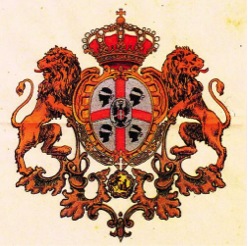The crest of the Quattro Mori
By Presidential Decree dated 5th July 1952, the Autonomous Region of Sardinia was granted an official crest: “In silver with a red cross and four bound Moors heads” (fig. 1). A later Regional Law, no. 10, dated 15th April 1999 stated that the crest is: “on a white background with a red cross and a bound Moor’s head in each quarter looking in the opposite direction of the luff” (luff = side of the flag sewn as a sheath where the rope used to raise the flag is passed through).

This crest chosen as a symbol of Sardinia has its origins in Iberian history. In fact, according to legend, in 1096 during the bloody battle of Alcoraz in Spain, that saw Peter I of Aragon fight against the Muslims, a knight appeared suddenly with a flaming cross on his chest who scared the Moors and made them flee. Peter I, after winning the battle, found four decapitated heads among the fallen in battle, and covered them in turbans embellished with precious stones, belonging to kings. The person was identified as Saint George and to remember the miracle, the King of Aragon created a stem that portrayed four heads on a red cross.
The crest appeared for the first time in Spain in 1281 (therefore much before the island was conquered, which began in 1323), on a lead seal of the royal clerk’s office for Peter the Great, King of Aragon and showed the Moors without crowns or bands on their heads (fig. 2).

In one page of the manuscript known as “Stemmario di Gelre”, kept in the Bibliothéque Royale in Brussels, dated between 1370 and 1386, the crest of the Quattro Mori appears for the first time as the symbol of Sardinia (fig. 3).

In 1474, when Ferdinand of Aragon married Isabella of Castille, the crown of Aragon and the kingdom of Castille were joined into the Kingdom of Spain. It was then that the Catalan bars were chosen as the new crest, putting the Quattro Mori to one side, and reserving them only for Sardinia. The first attestation of the crest on the island dates back to 1571 and was found in “Capitols de Cort del Stament militar de Serdenya”, i.e. The deeds of the military part of the Sardinian parliament. The Moors are shown on the front page of this document, without their eyes covered with bandages. They cover the forehead instead, according to a symbol that would indicate a crown.
The crest was then reproduced in publications of various times, geographic maps, coins, buildings. Starting in the 18th century, the Savoy crest was used instead of the Quattro Mori and it was only at this time that the Moors appeared with the bandages over their eyes (fig. 4).

In the 19th century, the crest of the Quattro Mori with the bandages over their eyes, began to be considered the identification symbol of Sardinia and according to an interpretation without historical grounds, was referred to as the Giudicato period. The idea that the four parts were a symbol of the victory of the four Giudicati over the Arabs began to spread. These discussions take their idea from a legend from the 17th century, according to which the crest celebrated the defeat of the Muslims in 1015, during the attempt to conquer the island by Mujahid al-Amiri, known in Italy as Museto.
After being adopted in 1921 as a symbol of the Sardinian Action Party and made the official crest of the Autonomous Region of Sardinia in 1952, the flag with the Quattro Mori continued to represent the Sardinian People that identifies itself with it.
Bibliografia
- B. FOIS Lo stemma dei Quattro mori, Sassari 1990.
- L. D’ARIENZO Lo scudo dei Quattro Mori, in I catalani in Sardegna, a cura di J. Carbonell, F. Manconi, Cinisello Balsamo 1984, pp. 199-206.

 VR
VR